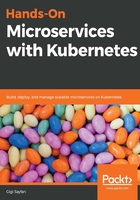
Role-based access control
Role-based access control (RBAC) is not required! You can perform authorization using other mechanisms in Kubernetes. However, it is a best practice. RBAC is based on two concepts: role and binding. A role is a set of permissions on resources defined as rules. There are two types of roles: Role, which applies to a single namespace, and ClusterRole, which applies to all namespaces in a cluster.
Here is a role in the default namespace that allows the getting, watching, and listing of all pods. Each role has three components: API groups, resources, and verbs:
kind: Role
apiVersion: rbac.authorization.k8s.io/v1
metadata:
namespace: default
name: pod-reader
rules:
- apiGroups: [""] # "" indicates the core API group
resources: ["pods"]
verbs: ["get", "watch", "list"]
Cluster roles are very similar, except there is no namespace field because they apply to all namespaces.
A binding is associating a list of subjects (users, user groups, or service accounts) with a role. There are two types of binding, RoleBinding and ClusterRoleBinding, which correspond to Role and ClusterRole.
kind: RoleBinding
apiVersion: rbac.authorization.k8s.io/v1
metadata:
name: pod-reader
namespace: default
subjects:
- kind: User
name: gigi # Name is case sensitive
apiGroup: rbac.authorization.k8s.io
roleRef:
kind: Role # must be Role or ClusterRole
name: pod-reader # must match the name of the Role or ClusterRole you bind to
apiGroup: rbac.authorization.k8s.io
It's interesting that you can bind a ClusterRole to a subject in a single namespace. This is convenient for defining roles that should be used in multiple namespaces, once as a cluster role, and then binding them to specific subjects in specific namespaces.
The cluster role binding is similar, but must bind a cluster role and always applies to the whole cluster.